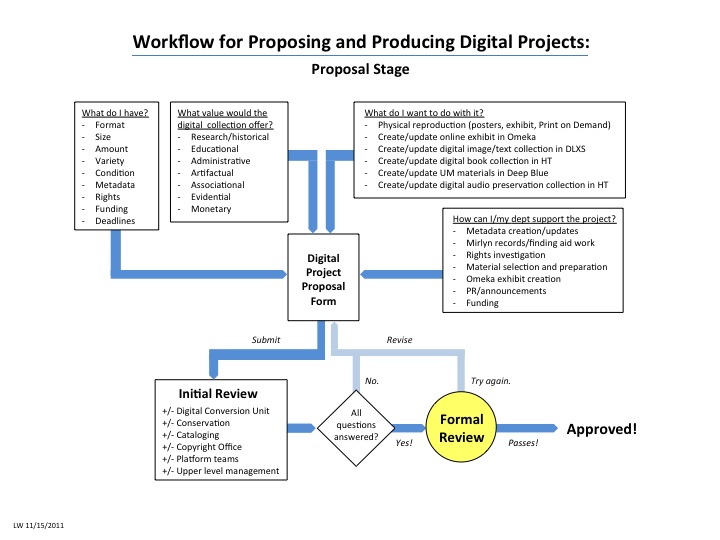It’s possible we should have written this blog post years ago, when we first created our workflow for how we shepherd digitization projects through our Digital Library. Well, we were busy creating it, that’s our excuse.
Three years later, we’re on our third iteration, which you can see here:
http://www.lib.umich.edu/digital-library-production-service-dlps/starting-digitization-project
We wanted a workflow because for a while we’d be running into multiple problems with content curation, preservation value, lack of metadata, objects at too low a resolution - pretty much everything that dogs the creation of a digital project.
So, when we first started, we created workflows in graphic form as an aid towards understanding what the work really entailed.

Workflow for Proposing and Producing Digital Projects: Proposal Stage
It’s really true that when we started we didn’t have a workflow, so we had to first determine who was or should be involved in the workflow, what those people should be responsible for, and create the opportunities for asking and answering questions at correct junctures. It really was “build from scratch.” About 9 months after starting that, we released the workflow online and started testing it with upcoming projects. We learned a lot from that! It allowed us to make revisions for phase two, including an enhanced FAQ that explained why creating better metadata is better for access, and why one repository may be a better choice over another one.
Another year or so in, and we were redesigning our web presence on the Library website. (We recently wrote a blog post about that.) As part of that process, we took another hard look at the digitization workflow from the standpoint of its usefulness on the website, and taking into account questions that arose in intervening projects. As a result of that, we created simplified formats for content stakeholders to use, a simplified set of questions (especially with respect to the rights and permissions parts of the workflow) and a much better thought-out set of steps on the workflow main page.
Of course, we continue to refine our questions and process. One of our current problems is determining how to handle unique problems in a potential collection. For instance, what if we decide to deposit some of the content in two different repositories (for different preservation and access reasons)? Strangely, it’s not just a question of whether or why we’d make that choice in the first place, it’s also a question of paying for the storage in both places. Often, those questions come up after we’ve had our initial meeting with the content stakeholders. It can be difficult and aggravating on both sides to restart questions about funding.
Another current problem is that on our web presence we say “Starting a Digitization Project.” Well, what if the material is already digitized and the content stakeholders only want it hosted? Should it say “Starting a Digital Project”? Is that too vague? Just vague enough?
We’ll be wrestling with those questions, and several others, shortly - for our fourth iteration.